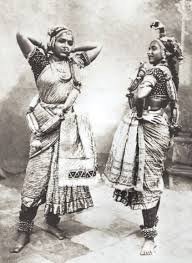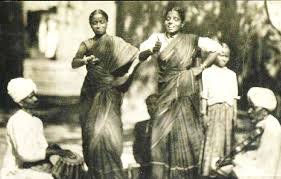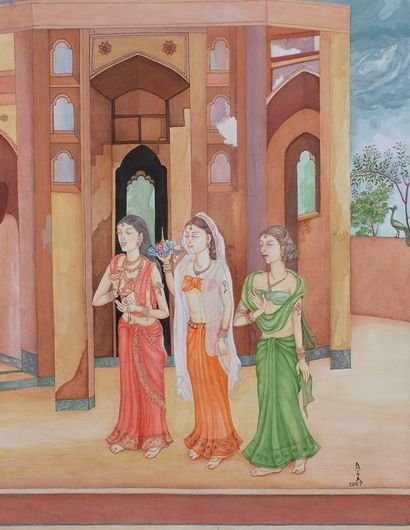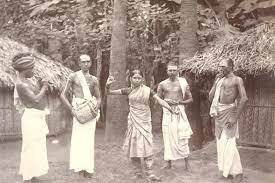THE DEVADASI SYSTEM: From Sacred wives of God to mistresses of many

From being venerated as the eternal brides of the god to being defiled by the eternal stigma of religious prostitution and impurity, the devadasis which still constitute a significant proportion of the population of India have a historical eminence spanning over 2000 years. Once a religious practice advocating music, dance and various art forms, the devadasi system has survived and devolved drastically, clutching the deeply penetrated roots of caste, religious stereotypes, vicious poverty and extreme sexual exploitation. World history is stained with such countless soul wrenching practices and traditions of gender biassed sexual slavery in the guise of religion, that everytime one confronts this oppressive reality, its remnants can still be well experienced.

In the Hindu tradition, the Sanskrit term ‘devadasi’ literally refers to a woman who is a servant of God or a Goddess. It is a practice in which a prepubescent girl who has not yet attained puberty is ceremoniously married or dedicated to a deity or goddess and therefore meant to take care of the temple whilst learning music and classical dance for performing in reverence to God as part of the rituals. After acquiring puberty, the practice also mandates the girl becoming sexually accessible to community members, resulting in these children being exploited by temple patrons and individuals from higher castes. In these temples, devadasis are expected to sexually gratify priests, landlords (zamindars), or higher caste patrons, as “serving them is considered equivalent to serving God” . The tradition of dedicating young girls to temples for sexual exploitation by priests or devotees was prevalent not only in India but in many ancient cultures of Europe, the Middle East, West Africa, and South Asia. For example, the practice of sexual servitude, Trokosi, is ubiquitous in West Africa.

There are more than 4 lakh devadasis living in India today who are not allowed to marry any mortal man and devoid of the right to inherit, and other fundamental rights provided by the Indian Constitution. Moreover, their children also face discrimination.
Tracing The Historical Trajectory of the practice
While there is a contentious debate among historians in locating the origin of the practice of devadasi, some scholars trace it as early as the third century while others mark the sixth century AD as its beginning and yet others date it back to the reign of Cholas, Cheras and Pandyas in the seventh century. It was mostly prevalent in southern India in regions of Karnataka, Tamil Nadu, Andhra Pradesh, Orissa, Maharashtra and parts of Gujarat, Rajasthan and Uttar Pradesh and Kolkata in West Bengal. The young girls, often belonging to the low caste, were given to the temple by their parents as an auspicious offering to please the deity and be blessed with good omen. Authors of both early (Ramachandran 1900) and recent (Saskia 1998, 60) critical works agree that the devadasi dedication initially had noble intentions, where these women were meant to serve Gods as temple handmaidens through daily prayers, sacred dance and music defined as ‘sebaets,’ they performed within and outside temple premises, and were well versed in the scriptures. Believed to be amaranthine suhagans, their presence in marriage ceremony was crucial for making mangalsutra which if worn by the bride blessed her with the boon to die as a suhagan. With the term devadasi encompassing various female communities like gudisani (temple lady), bhogam (embodiment of enjoyment), kalavati (receptacle of the arts), and as devaradiyal (slave of god), they were considered sacred, intended to remain celibate for life, and had a respectable stature in society being acknowledged on the same level as brahmins.

In ancient times, devadasis were classified into seven categories. The first, “Dutta Devadasi,” referred to daughters offered to the temple by their parents. “Hruta Devadasi” women were kidnapped and forced into service, while “Bikrita Devadasi” referred to those who were sold to the temple. Women who voluntarily became devadasis were called “Bhrutya Devadasi.” “Alankara Devadasi” denoted those who attained proficiency and were offered to the temple. Devadasis known as “Gopika” or “Rudraganika” were paid for their performances. Like other religions, there were upper and lower castes among devadasis.
Obeliscolychny of Arts
Considered as a patron of arts, the devadasi system was totally different from what it exists today. The devadasis were well educated in shastra (sacred scriptures of Hinduism), sahitya (literature), and sangeeta (music), and were experts in art forms pertaining to the alankara shastra, or lyrical embellishment. The devadasis learned and performed classical Indian dances such as Sadir and Odissi, which later evolved into Bharatanatyam in the early 20th century. As hereditary custodians of these cultural practices, their intricate performances elevated their status as receptacles of the arts. Even the most prominent vocalists such as MS Subbulakshmi, Lata Mangeshkar, and her sister Asha Bhonsle, are believed to have devadasi ancestors. Temples with more devadasis were seen as more prestigious and their sacred performances in temples and for royalty enhanced the prestige of kings and temples. They were rewarded for their art and service with gifts or tax-free land from temples or feudal kingdoms.

Evolution and degradation
Devadasis were dedicated to temple deities, such as Yellamma-Renuka, the Goddess of fertility, and were considered married to God, preventing them from marrying mortals. This practice, ongoing for at least 2,000 years, granted them high social prestige. Some scholars argue that upper-caste devadasis performed rituals in temples, while lower-caste ones undertook errands like washing, cleaning, and fanning the deity. Regardless of their category, all their services were dedicated to worshipping their husband, the deity. They stood as a bridge between God and devotees through their divine connection with the deity bereft of worldly interests. Even today, in Saundatti town’s annual religious celebration for Goddess Yellamma, elderly devadasis, known as Jogathis, facilitate the worshippers’ connection with the goddess. Over time, during the Chola period (850-1300 CE), they began providing sexual favours to kings, priests, and temple patrons, although they remained respected and revered .

The Dedication Ceremony involved pre-pubescent devadasis being dedicated to a temple deity, signalling their future availability for sexual liaisons with patrons, typically kings. The ceremony’s cost was often covered by a man who anticipated becoming the girl’s patron after she reached puberty and ‘a deflowering ceremony’ would take place where her patron or sexual partner, usually wealthy and connected to royalty was chosen by arrangement with her mother and grandmother. This patron could maintain a permanent or temporary relationship or end it after the ceremony. Devadasis could still choose other partners unless restricted by the patron. Therefore, the saying in the Marathi culture goes as “Devadasi devachi bayako, saryagavachi” (Servant of God, but the wife of the whole town). But this didn’t have any negative connotation, rather this was seen as an honourable profession with immense independence while being an intricate part of the society. They received gifts from royal patronage rather than payment for their services, distinguishing them from commercial sex workers and granting them respect and rights. Therefore, they evolved as a different sub caste with their own rules of conduct, social behaviour and unique lifestyle.

However, the devadasis’ status reached its zenith in the 10th and 11th centuries CE, paralleling the prominence of Hindu temples. Altekar cites their decline began with Islamic invasions, which destroyed temples and displaced devadasis. The British rule in the 19th century further eroded their support as they were seen violating victorian morality, leading devadasis to offer sexual favours to common temple visitors. This period marked their denigration, as they were forced into other work and equated with commercial prostitutes. Victorian colonialism and nationalist patriarchy further marginalised them, pushing impoverished devadasis into sexual slavery and increased social exploitation.
The practice of devadasis has deteriorated from temple worship, dancing, and singing to an excuse for sexual harassment in modern India. Despite laws abolishing the practice, devadasis today often beg for survival rather than entertain royalty or divinity. The current practice is linked more to sex trade and exploitation of lower castes than to temple worship. According to William Dalrymple, contemporary devadasis lack proficiency in the arts, literacy, and wealth, differing vastly from their historical counterparts who were literate and from noble families. Dedications to deities like Yellamma continue, perpetuating a cycle of sex slavery and child prostitution. Devadasis face social exclusion, political and economic discrimination, and stigma, with many remaining in their native villages without prospects for improvement according to UNICEF report of 2001. In some southern Indian states, they are restricted from other professions, ensuring their continued subservience to the practice.

The devadasi system, described as “religious prostitution,” has devolved into institutionalised sexual exploitation of the poorest segments of Indian society, primarily Dalits, particularly from the Madiga, Valmiki, Mahar, and Matang castes. Families often dedicate girls to the system for income, with devadasis considered “public property” in their villages. Most devadasis are single mothers, unable to register their patrons as their children’s fathers. Though limited to a few states, the devadasi problem is national due to trafficking from other regions and the movement of devadasis to cities like Mumbai and Kolkata for prostitution. The International Labour Organisation (ILO) has identified the devadasi system as a major link to the trafficking of girls for commercial exploitation, resulting in gross sexual servitude, vulnerability to sexually transmitted diseases and lifelong stigma.
LEGISLATIVE ACTIONS TO COMBAT THE DEVADASI SYSTEM
The devadasi system, considered a form of “religious prostitution,” has been banned through various laws and initiatives. Initially outlawed under British rule by the Indian Penal Code Amendment Act of 1924, the practice of dedicating girls for prostitution was declared illegal (sections 372 and 373). The Bombay Devadasi Protection Act of 1934, Madras Devadasi (Prevention of Dedication) Act of 1947, and the Karnataka Devadasis (Prohibition of Dedication) Act of 1982 further criminalised the practice. The Andhra Pradesh Devadasis (Prohibition of Dedication) Act of 1988 and the Maharashtra Devadasi System (Abolition) Act of 2005 continued these efforts by declaring the practice illegal. The Vimochana Sangha School was established in 1990 in Malabad to prevent and protect girl children of devadasis from involvement in commercial prostitution. Additionally, general legislations like the Scheduled Castes and Scheduled Tribes (Prevention of Atrocities) Act of 1989, the Immoral Traffic (Prevention) Act of 1956, the Protection of Children from Sexual Offences Act of 2012, and international conventions against slavery and exploitation support the prohibition. Despite these laws, reports indicate insufficient action by the Indian government to eliminate the practice completely.

In 2015, the death of Sashimani Devi at the age of 92, the last devadasi of Puri, marked the end of the ancient tradition there. Despite reforms, the devadasi system persists in parts of South India, including Karnataka, Tamil Nadu, Andhra Pradesh, Maharashtra, and Orissa, but now for different reasons. Initially rooted in Bhakti, the practice devolved into a social evil where girls were seen as liabilities and forced into the system, turning them into assets for their families by generating income. Poverty, social pressure, poor enforcement of laws, caste and religious customs, and superstitions, such as dedicating a girl to cure illness or secure a male heir, still drive this practice. Addressing the deeply entrenched cultural and socio-economic factors sustaining this practice is crucial for its eradication and emancipation of God’s beloved women in the subjugating patriarchal societal structure. The contemporary miserable and daunting state of these devadasis require their immediate rehabilitation and inclusion in the society to secure them a life to live with human dignity.


